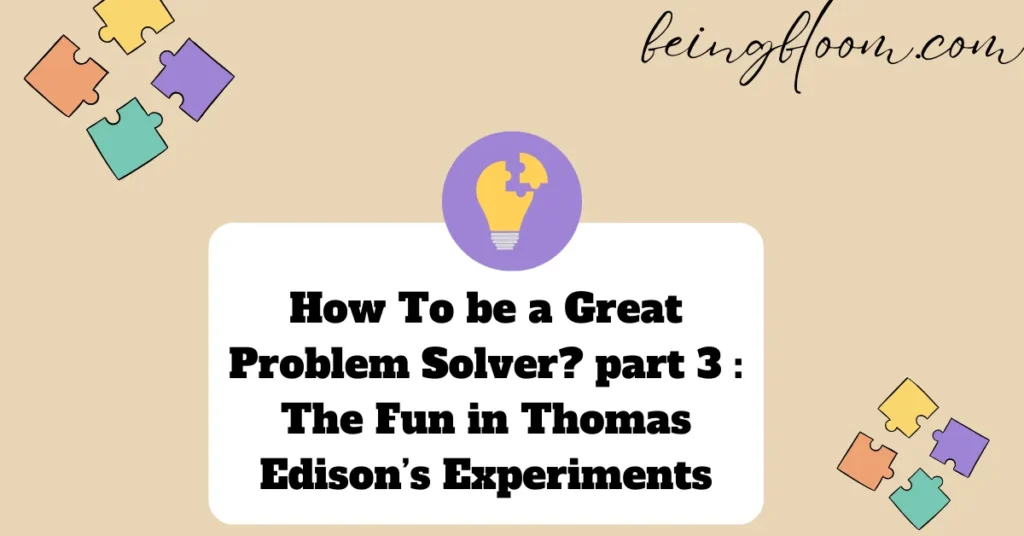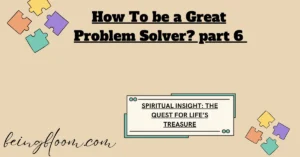
Step into the unusual world of Thomas Edison—the guy who came up with the light bulb. Imagine Edison working in his lab, surrounded by wires, all sorts of chemicals, and maybe a few mice scurrying around. Now picture him with a big smile, even though his latest experiment didn’t work out. He once said, “I have not failed. I’ve just found 10,000 ways that won’t work. ” Yes, that’s right—10,000 ways! Edison didn’t view failure as a setback; he saw it as a chance to learn. Each mistake was simply another note in the music of his success.
Do you ever feel like your problems are the bad guys in your story? Actually, they act more like side characters, adding some excitement and fun to the adventures of your life. For Edison, problems weren’t really problems at all—they were fun challenges that kept him motivated. Edison was not only a smart inventor; he was also a passionate problem-solver who enjoyed taking each failure as a new game. Every challenge he faced was like another level in a video game.
So, let’s jump into this with the same excitement. We’re about to explore how solving problems can be both fun and thrilling. Get ready—because tackling issues isn’t just helpful, it can also be really exciting! Problems aren’t just things in your way; they are openings to amazing adventures. Don’t forget, a problem often hides a chance for a great journey. And if you find yourself thinking, “Wow, this is complicated,” just hold on! Let’s grab our spoons and savor the tasty tale of challenges. Problems pop up in our lives—sometimes they’re big, and other times they’re as small as a feather. Have you ever realized how good it feels when you actually figure out a problem? Let me tell you—when you solve a problem, you feel like a hero coming back from a fight. Each problem is like a thrilling battle, where you are the champion. You work hard, beat the odds, and that win is more satisfying than anything else. Problems aren’t just things to get through; they are amazing chances to dream big and enjoy life!
Now, picture your favorite blanket laid out nicely, a basket packed with tasty snacks, and a day so lovely that it feels almost unreal. You reach for that sandwich when suddenly—buzz! —a fly zooms past you. Surprise! You’ve just met an old friend: the problem. The thing about problems is that they show up without being invited, irritating you, and somehow they seem to linger like clingy guests at your gathering. Their signature? They are unwanted, and they keep returning again and again. They show up at the “perfect” moment, as if they’ve been hiding nearby, just waiting to ruin your picnic. But honestly, problems aren’t really the villains in our lives. In fact, they can be the surprising heroes in our personal stories. Think of them as the unexpected twists in an exciting movie—those moments that add fun and flavor to the tale. They create drama, excitement, and yes, a bit of chaos. And let’s face it—chaos can sometimes be a great motivator, right?
So, what are problems really? They’re that fly buzzing around your food. They are the surprise bill, the key you can’t find, or that coffee spill on your favorite shirt. They’re those little annoyances that make you throw your hands up and say, “Oh, not this again! ”
Problems actually push you, make you think, and most importantly—they help you grow. Imagine life as a game show where problems are surprise tasks. Each problem is like a new level you have to face. You tackle it, beat it, and then—cue the awesome dance—you celebrate your win.
The bigger the problem, the better it feels when you overcome it. Problems are life’s way of encouraging you to take on challenges, reminding you that you are the hero in this exciting journey. So the next time you face a problem, don’t just see it as a weight on your shoulders. The best stories are those where the hero confronts tough obstacles and still comes out on top. So, grab that pesky fly, smile when things get tough, and turn those annoying problems into stepping stones on your road to success.
Throughout life, we encounter problems in many forms and sizes. To say it simply, they can be tiny annoyances or huge crises. Each problem tells us an exciting, unique story in the big adventure of life. The ‘small’ problems feel like quick detours on our journey, while the ‘huge’ ones can test our strength more than any superhero fight. Problems motivate us to try new things, take on new challenges, and keep moving ahead.
Solving problems is like going on an exciting journey. Whenever you face one, you’re not just fixing an issue—you’re getting better at the big game of life. Yes, life is like an amazing video game where every trouble is a new challenge! Take on the task! Imagine that you are the hero in your own story. Think of issues as dragons that you need to defeat. The more dragons you conquer, the stronger and better you get. Each time you solve a problem, it’s like finding a treasure filled with valuable experiences and feelings of victory.
Picture this—you’re dealing with a hard and tricky project. Your workspace feels like a fighting ground, your boss is a tough enemy, deadlines are dangerous traps, and solutions are your powerful weapon. Every small win gets you closer to beating the boss, and your prize is the wonderful feeling of success (and maybe a compliment from your boss, too).
So, why is this so thrilling? Because every problem lets you grow, learn, and sometimes even have fun. It’s not just about getting through tough times; it’s about taking on the challenge and enjoying the solution. Each problem you fix gives you a new skill, making you better at handling the ups and downs of life’s grand journey. Remember, problems aren’t just things that get in your way—they’re hidden chances. They allow you to practice your problem-solving skills and come out on top. So, the next time you encounter a problem, don’t just frown. Look at it as a new level, welcome it as an upgrade, and consider it as an exciting adventure that makes you better at solving problems every day.
The mental reward: the rush of dopamine. Recognize how great it feels when you fix problems. It’s as if your brain has created a hidden game that gives you rewards each time you tackle a challenge. Think back to when you earned a gold star on your report card. That feeling of pride and happiness? Now, think of that same feeling, but instead of a shiny sticker, your brain is sending you a rush of dopamine. When you figure out problems, your brain gets a little dopamine bonus that lifts your spirits. It’s like your brain is cheering, “Hey, you did something awesome! ” This feeling is just like getting that gold star for doing well in school. Why does this happen? Because solving problems is like playing a game for your mind. Each time you finish a level or solve a tough puzzle, your brain enjoys a boost of dopamine. It’s your brain’s way of celebrating your wins. So, the next time you encounter a challenge, keep in mind that it’s not only a hurdle—it’s an opportunity for a mental celebration. Tackle it, solve it, and soak in that joyful rush of dopamine. Every problem you solve becomes a fun and exciting adventure.
Absolutely, solving problems feels like wrapping your brain in a warm glow of happiness! Isn’t that fantastic? Imagine this: you’ve figured out a tough question—a question that took all your focus. You might have spent hours, days, or even weeks on it. And now, you’ve found the answer. Wow! Isn’t that a great feeling? When you figure out a problem, the chemicals in your brain throw a special celebration. That chemical is dopamine. Dopamine acts as a “celebration signal” that makes you feel good and reminds you, “You’re awesome! ” It’s just like receiving that gold star in school for doing well. But here, instead of getting a report card, your own mind is rewarding you with a gold star. This is the best way to confirm that your hard work is paying off. For instance, picture yourself in college, also holding down a job, but having a tough time managing everything. You try really hard, but nothing seems to get better. Even so, you keep pushing through, and finally, you figure out a great way to manage your time. Because of that, you start to feel more energetic and happy—your brain gets a big burst of dopamine. It’s like a fantastic prize saying, “You’re on the right track, and your efforts are truly impressive! ” This changes how you think. Dealing with challenges isn’t just about feeling stressed; it’s more like giving your brain a fun treat that brings happiness. Solving problems turns into an exciting game where you come out on top, and dopamine is the reward that makes life enjoyable. So, see every problem as a fun adventure, because tucked within it is a hidden treasure of your mind’s gold star. Once you understand this, you’ll tackle challenges with confidence. Always remember: every time you solve a problem, your brain gets a gold star, adding a sparkling bit of joy to your life.
Real-Life Examples: Problem-Solving and Its Thrill
Let’s dive into the fascinating area of solving problems and look closely at some real-life stories of inspiration. Get ready for an exciting journey that will motivate you!
1. Elon Musk: Adventures in Space
Picture this: in 2008, SpaceX had three rocket launches that didn’t work out. These weren’t just minor issues; they caused big money and technical troubles. Musk worked extremely hard to make sure SpaceX’s Falcon 1 rocket would be successful. Rather than viewing these setbacks as failures, Musk saw them as chances to learn how to solve issues. He used the lessons from these tough times to enhance the technology and encourage his team, and in 2008, he finally made the Falcon 1 fly successfully. Musk’s adventure showed that embracing challenges and learning from them is essential for achieving great things.
2. Serena Williams: From Injury to Victory
Serena Williams’ journey in tennis is a great example of overcoming obstacles. In 2011, she had to take a long break because of a serious foot injury. She set her mind on coming back stronger and excelling in her game. After working hard on her recovery, she returned to the court. In 2017, just a few months after her break, she won the Australian Open. Her comeback is not just about winning in sports but also about the sheer determination to face life’s hardest times. Solving problems for her meant staying persistent. Serena Williams showed that pushing through difficulties makes the path to success really exciting.
3. Steve Jobs: From Garage to Global
Steve Jobs’ story is an incredible source of motivation. In 1976, he started Apple in a regular garage with Wozniak. They imagined building a big tech company, but in the beginning, they faced numerous struggles. The company was having a tough time, and in 1985, Jobs was kicked out of Apple. But he didn’t quit. He started another company and later, in 1997, came back to Apple. Upon his return, he introduced groundbreaking products like the iPod, iPhone, and iPad, which changed the way we use technology. Jobs’ willingness to experiment and work hard showed that solving problems is crucial in shaping the future.
4. J. K. Rowling: From Welfare to Wizardry
J. K. Rowling’s journey is not just about achieving success in writing but also a fantastic example of overcoming challenges. Before she created the magical world of Hogwarts, Rowling was a single mom relying on government assistance. She struggled financially and personally. Her first Harry Potter book was turned down by 12 different publishers. However, even in tough times, Rowling kept pushing and finally, Harry Potter was published. Her imagination created a world that became beloved worldwide. Rowling’s determination showed that solving problems is about making your dreams come true.
These true stories are more than just motivation; they show us the exciting journey of facing difficulties and finding answers. Whether it’s Elon Musk exploring space, Serena Williams winning tennis matches, Steve Jobs changing technology, or J. K. Rowling succeeding in writing, each of these famous people used their challenges to create new chances. So, when you run into a tough situation, think of these great figures. Accept the problems, have fun with the journey, and be happy when you come up with solutions.
“Now that you’ve seen how great leaders solve problems, it’s time to learn the exact steps. Don’t miss Part 4: Problem-Solving Formula.”







